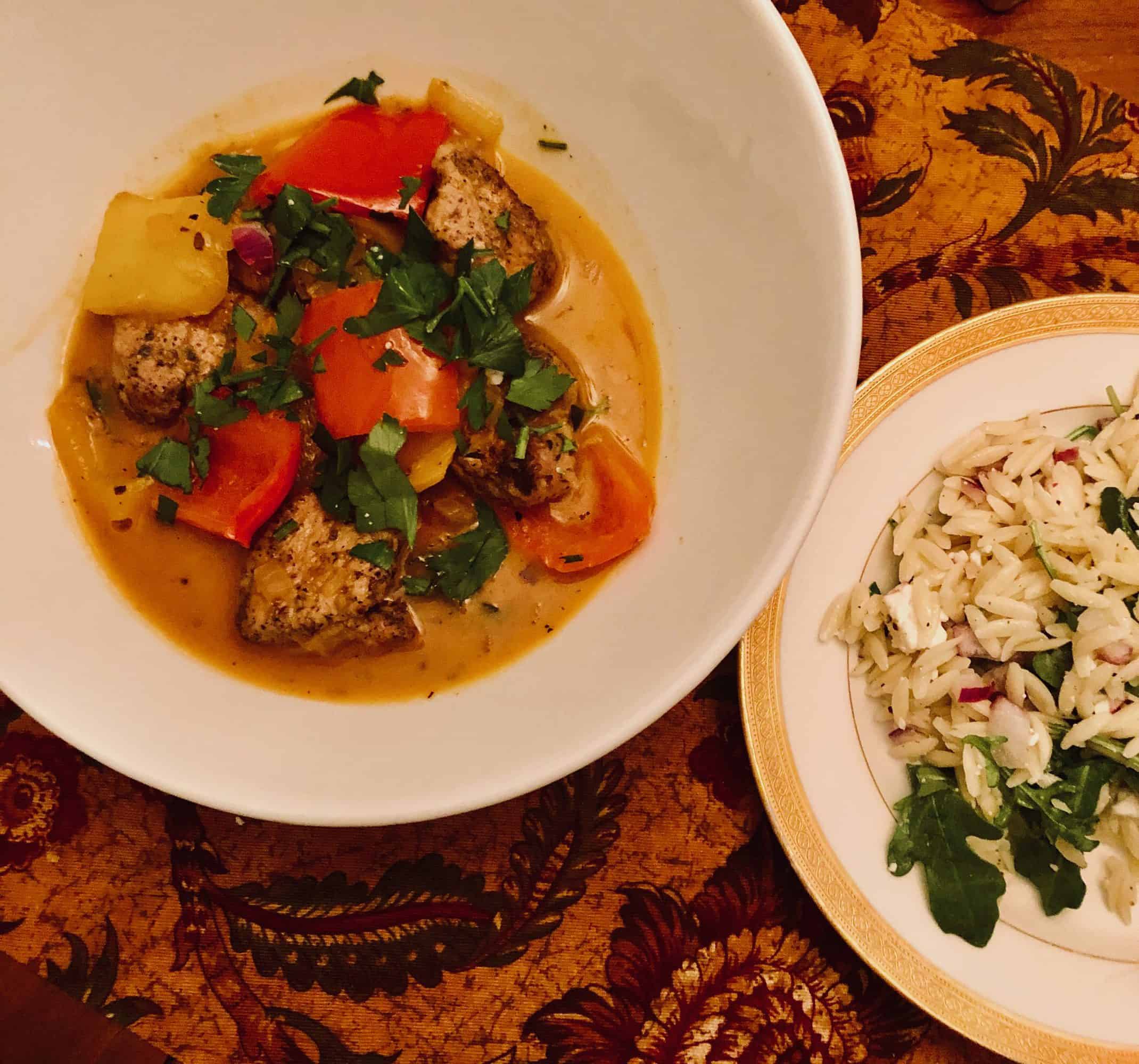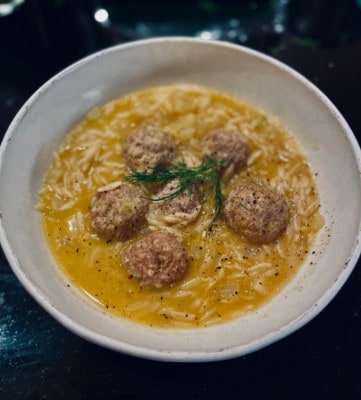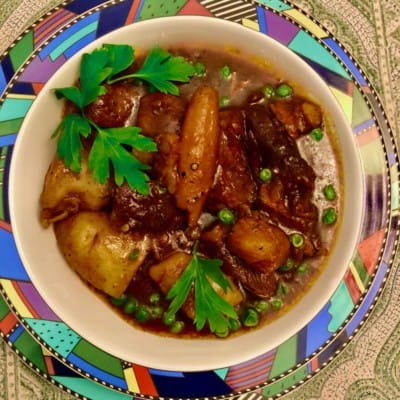 What’s in a name? Plenty! Drunken Pork Stew Proves it.
What’s in a name? Plenty! Drunken Pork Stew Proves it.
I have to admit, it was its picture in Fine Cooking–and not its name– that made me want to 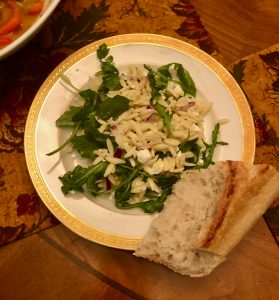 cook this extraordinarily easy-to-make stew. Tony Rosenfeld, who wrote “Savory Pork Stews”, says it’s “a quick take on bekri meze, the classic Greek appetizer, (that) pairs chunks of pork with a good splash of wine, (hence the stew’s name).” But the real draw here isn’t the wine. It’s the wonderful broth flavored with bell peppers and onions. And isn’t broth what makes stews such a comfort food? Chunks of a good baguette are essential to the pleasure of a great stew. And to add to the Greek theme, Rosenfeld suggested an Arugula, Feta, and Orzo Salad to accompany the dish. We gladly obliged.
cook this extraordinarily easy-to-make stew. Tony Rosenfeld, who wrote “Savory Pork Stews”, says it’s “a quick take on bekri meze, the classic Greek appetizer, (that) pairs chunks of pork with a good splash of wine, (hence the stew’s name).” But the real draw here isn’t the wine. It’s the wonderful broth flavored with bell peppers and onions. And isn’t broth what makes stews such a comfort food? Chunks of a good baguette are essential to the pleasure of a great stew. And to add to the Greek theme, Rosenfeld suggested an Arugula, Feta, and Orzo Salad to accompany the dish. We gladly obliged.
Pork. The Other White Meat.
By any measure, the advertising campaign for the National Pork Board must be counted as one of the most successful in history. Debuting in 1987, it pitched Pork as an alternative to Chicken or Turkey. With an advertising budget of $7,000,000, Pork sales in the United States rose 20 percent reaching $30 billion annually by 1991. Contrast that to the results of the National Cattlemen’s Beef Association. They spent $30,000,000 on “Beef. It’s what’s for dinner.” From 1987’s 69.5 lbs. per American, beef consumption declined to 62 lbs. per capita in 2003. But is pork a white meat? Most culinary traditions consider pork white meat. Medical researchers and the United States Department of Agriculture classify it as red meat. By the way, in March 2011, the National Pork Board replaced the slogan with a new one: “Pork. Be inspired.”
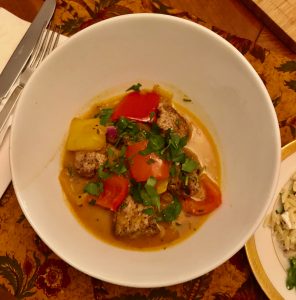 In its desire to be considered ‘healthy’, pork producers’ reduced the fat. Did that affect the flavor?
In its desire to be considered ‘healthy’, pork producers’ reduced the fat. Did that affect the flavor?
Pork’s push to become ‘the other white meat’ meant much leaner hogs. Fat being a flavor carrier, when pork went on a diet, its impact on the palate diminished. Of all cuts, the pork loin used in Drunken Greek Pork Stew, is leanest. Flavor is built here by marinating it. The pork absorbs the oregano, cumin, salt and pepper in the recipe. Rosenfeld recommends using Mediterranean Oregano. Since I had none, my solution was to double the proportions of each spice. I also halved the amount of Pork tenderloin to serve just 2. Today’s recipe is for 4 servings with my double amount of seasoning. After the marinade, the meat is browned until it’s caramelized. Then the meat meets the intensely flavored broth and its gloriously colorful bell peppers and onion. Here are the recipes for both Stew and Orzo Salad. After them, some other stews you may like.
Drunken Greek Pork Stew
A quick take on a Greek appetizer, this robust stew pairs tender pieces of pork with bell peppers and onion broth laced with a good splash of wine.

Ingredients
- 2 pork tenderloins (about 2 lbs. total) trimmed of fat and cut into 1-inch pieces
- Kosher Salt and freshly ground black pepper
- 4 tsp. dried oregano, divided
- 4 tsp. ground cumin, divided
- 2 tbs. Cornstarch
- 3 tbs. Olive Oil, divided
- 1 red bell pepper, seeded and cut into 1-inch dice
- 1 yellow bell pepper, seeded and cut into 1-inch dice
- 1 medium Spanish Onion, finely diced
- 2 bay leaves
- 1 tbs. tomato paste
- 1 tsp. minced garlic
- 3/4 cup dry white wine like Pinot Grigio
- 1 1/2 cups reduced-sodium Chicken Broth
- 1/2 cup coarsely chopped fresh flat-leaf parsley
Directions
- Step 1 Toss the pork with 1 tsp. salt 1 1/2 tsp black pepper, 2 tsp. each oregano and cumin. Let sit for 1 hour at room temperature or refrigerate for up to 24 hours.
- Step 2 Sprinkle the pork with cornstarch and toss to coat. Heat a large Dutch Oven over medium-high heat. Add 2 tbs. olive oil and when shimmering, add half the pork in an even layer. Cook, undisturbed, until browned around the edges and pork releases when lifted with tongs, about two minutes.
- Step 3 Reduce heat to medium. Flip and cook until browned, about 2 minutes Transfer to a plate. Cook the remaining pork, in the same manner, transfer to the plate.
- Step 4 Reduce the heat to medium. Add the remaining 1 tbs. of the oil and the bell peppers, onion, and bay leaves. Sprinkle with 1/2 tsp. salt, increase heat to medium-high and cook, stirring to incorporate any browned bits on the bottom of the pot until the peppers and onion soften and brown in places, about 6 minutes. Add the tomato paste, garlic, and the remaining 2 tsp. of oregano and 2 tsp. of cumin, and cook, stirring for 1 minute.
- Step 5 Add the wine and cook, stirring until it’s almost evaporated about 4 minutes. Add the broth, bring to a simmer, and then reduce the heat to medium-low. Add the pork and any accumulated juices and cook, stirring occasionally, until the pot is cooked through and the broth thickens about 15 minutes.
- Step 6 Stir in half the parsley and season generously with salt and pepper. Serve, sprinkled with the remaining parsley.
Warm Orzo Salad with Feta, Kalamata Olives and Arugula
A salute to the Greeks, this lovely lemony salad is full of flavor.

Ingredients
- 1/2 lb. orzo pasta
- salt
- zest of 1 large lemon
- juice of 1 large lemon (about 1/4 cup)
- 1/2 cup olive oil
- 1 small red onion diced,
- 1 cup Feta Cheese, crumbled
- 1/2 cup Kalamata Olives, chopped
- 3 cups Arugula
- 1/2 cup green onions, greens only sliced
- 1/2 cup fresh flat-leaf parsley, chopped
Directions
- Step 1 Bring 5 quarts of water to a rolling boil and add 1/4 cup salt. Add the orzo pasta to the water and stir. Bring the water back up to a boil. Stirring occasionally, cook for 9 minutes.
- Step 2 While the orzo is cooking, zest and juice the lemons into a large mixing bowl, and whisk in the olive oil.
- Step 3 When the orzo is done cooking, drain it (do not rinse), and toss it with the dressing while still hot.
- Step 4 Allow the pasta and dressing to cool slightly while you ready the rest of the ingredients.
- Step 5 Fold in the red onion, Feta Cheese, Kalamata Olives, and the Arugula.
- Step 6 Serve warm
Ribollita, the "Flexitarian" Stew adapted from Mark Bittman in The New York Times
